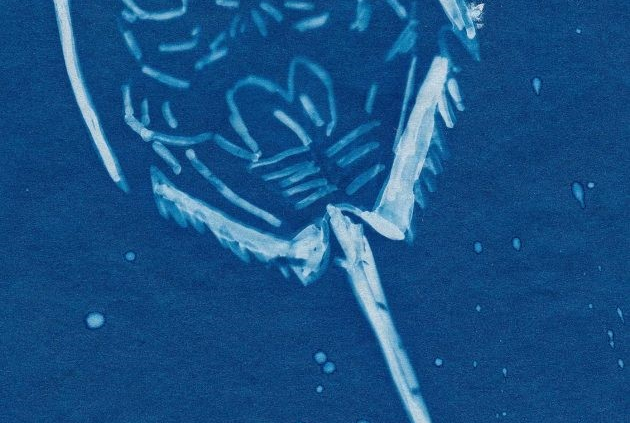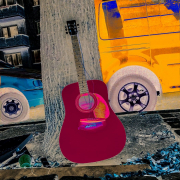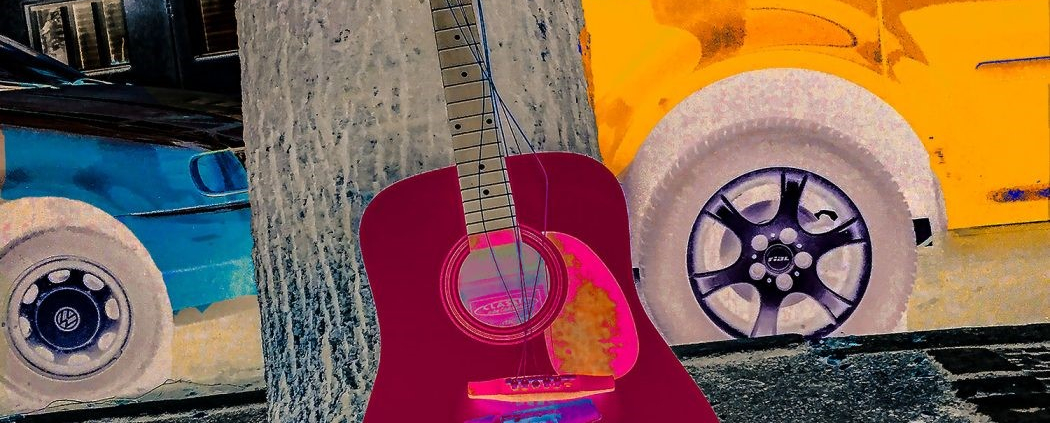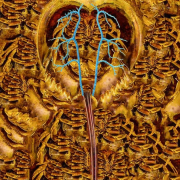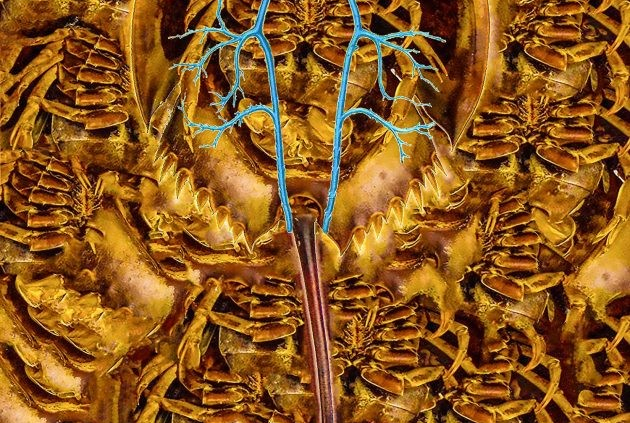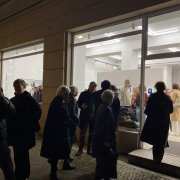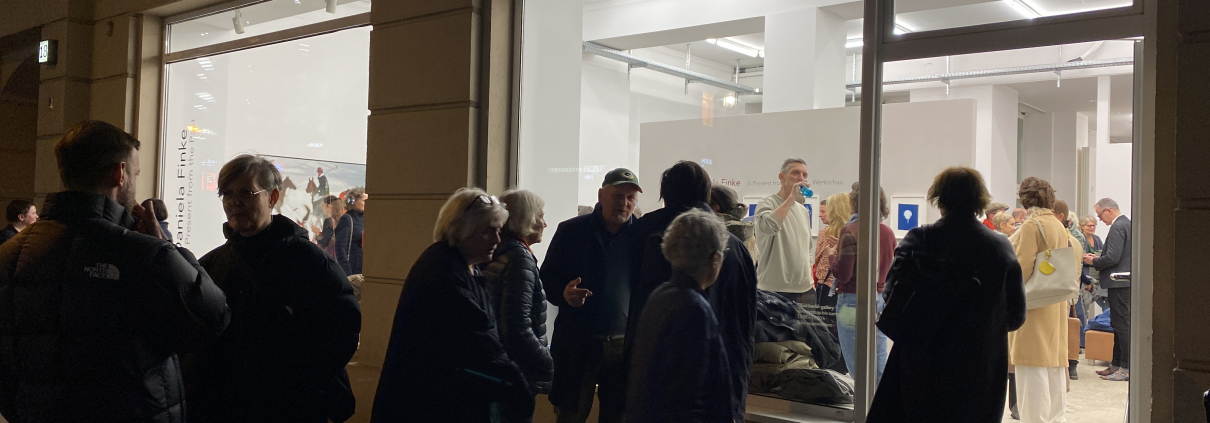Daniela Finke, A Present from the Past – Retrospective
Daniela Finke, A Present from the Past – Retrospective
In this exhibition we show selected works from current and older series by the Berlin-based photo artist Daniela Finke. The focus of the exhibition is her latest series of works, “A Present from the Past”, in which the artist explores the memorable appearance of the Horseshoe Crabs (Limulidae), an endangered species whose age is estimated at over 400 million years and whose bluish blood is of great medical use to mankind.
In her works, Daniela Finke explores the invisible relationships of the visible world. In bright colours, she marks bodies, architectures, everyday things or natural phenomena, putting them out of focus. In this way, her pictures bring elementary forms and relationships to light and turn the inside of perception inside out. Like magical illuminations of the unconscious, abstract and concrete at the same time, her series play through the temporary patterns of perception and reveal their fragile, rationally hardly graspable shape.
The exhibition focuses on the latest series of works “A Present from the Past”, in which the artist deals with the ancient species of horseshoe crabs (Limulidae). In the differently edited and staged photographs, the contour of the animal appears again and again as a stereotypical sign: as a constellation or a scarab-like gem, as a shadow in the ocean blue of cyanotypes, which refers to the colouring of the coveted bluish blood of the horseshoe crabs.
A Present from the Past – not only the endangered species of Limulidae, but also other pictorial motifs in this work show seem to be a gift from the past: white-blue glacier fronts from Patagonia, discarded everyday things from the series “Discarded” or canonical buildings of modern architecture. By reducing the forms, Daniela Finke makes structures of the living visible and releases a dancing present.
A Present from the Past (since 2015/2023)
The series “A Present from the Past”, which gives the exhibition its title, explores the memorable appearance of the horseshoe crabs (Limulidae), a species estimated to be over 400 million years old that today lives mainly in tropical waters, on the American Atlantic coast and in Southeast Asia. Their alien-like appearance with their spiked carapace and arrowhead-like tail at first makes them look like threatening mythical creatures. Yet their scientific study and exploitation in Europe dates back to the beginning of the 17th century. A bacterial test made from the bluish blood of the animals is now one of the medical standards, which is why crayfish are an endangered species. Attempts at gentle extraction or synthetic production of the blood have done little to change this.
In the variously edited and staged photographs of the series, the outline of the crab appears again and again as a stereotypical sign, with changing, never quite clear meaning. It stands for the mystery and intangibility of Limulus’ origin as well as for its scientific, mythical or individual exploitation. Whether as a constellation or a scarab-like gem, as a shadow in the ocean blue of cyanotypes referring to the coveted blue blood of horseshoe crabs: dissected, shone through and cut up, this body reveals its complete otherness: how could the species survive for so long? How do these animals, with their pairs of eyes, receive the world of the present, in which, after millions of years of survival, they may be facing extinction?
Nocturne (2022)
In the series “Nocturne” Daniela Finke visualises digital sound fragments, artistically free. In reference to the façade of the Berlin Philharmonie building (Hans Scharoun), she uses gold-anodised carrier material for the image motifs. Depending on the incidence of light, light reflections create a moving surface, a constantly changing backdrop.
Discarded (2020/21)
The series of works “Ausgesetzt/Discarded” shows objects that have been discarded on the streets of Berlin. They were found by the artist over the years on her way to her studio. Familiar objects – crockery, shoes, furniture, books or a guitar – alternate with curious ones: a single egg cup with arms, legs and a face, a cap with a plastic visor or with things whose purpose may no longer be apparent. The environments in which the objects are deposited also come into view: Cars at the side of the road, trees, house fronts, an electricity box with billboards, a pharmacy sign. The environments, like the deposited objects, are partly decorated with graffiti: A tag with the Michelin man can be seen on a mobile home, the words Youth is Crime on a dustbin; the faces of a couple lying in bed and the words Home Street Home have been sprayed on a discarded mattress.
While advertising photography creates views of environments in which the meaning and appeal of the advertised goods are atmospherically totalised, the series “Ausgesetzt/Discarded” shows a world of goods whose aesthetic message is refracted by its surroundings. In the tradition of vanitas motifs, the negative inversion of the images with their ghostly colouring and contrasting leads into an intermediate realm in which the decayed and dead visually come to life once again for the moment of sight. Here, in the counter-world to consumption embodied by the temple-like architecture of the Galeries Lafayette in Paris, all distinction and vanity of possession is eliminated, and things reveal their transcendentless, creaturely mortality in their exposure on the street.
A Dance of the Stars (since 2019) / A Dance of Abstraction (since 2018)
In her image series “Dance of the Stars” and “Dance of Abstraction”, Daniela Finke refers to canonical buildings of modern and postmodern architecture: Mies van der Rohe’s Barcelona Pavilion, Frank Lloyd Wright’s Falling Water, Hans Scharoun’s building in the Weissenhof estate or various motifs of the Bauhaus – but also architectures by Zaha Hadid, Renzo Piano or Frank Gehry appear quite differently in the images than in those traditional architectural photographs that embody the epitome of their historical tradition. In Daniela Finke’s works, these buildings can sometimes hardly be identified without the references in the picture titles. The strict forms of the architectures blur, seem to dance or dissolve in abstract, luminous colour schemes and light reflections.
Just as the artist seeks to make visible structures of the living in her series on living bodies such as “Baywatch” or “A Present from the Past” by reducing forms, she exposes a dancing present in the architectural structures that has disappeared behind her iconic modernist awareness of form.
Waking Night (since 2013)
Daniela Finke’s series “Waking Night” shows nocturnal views from various cities: Street scenes, a petrol station, individual buildings. The camera captures both entire city panoramas and then focuses again on details at the roadside such as telephone boxes or a single car in an empty car park. Some scenes hint at cinematic clichés: a pair of lovers on a wall; a homeless man sifting through piles of rubbish. Other motifs, such as the illuminated facades of modern buildings, seem devoid of people and abstract.
The extensive creation of lighting moods connects all motifs: while in classical night photography since Brassaï the incidence of artificial city lighting has been used sparingly to increase contrasts and avoid disturbances and image noise, in the digital processing of her photographs Finke expands the light diffusion to the point of diffusing the actual light sources. This often makes the images appear as if the cities and buildings were not the motif at all, but rather the specific spaces and sceneries created by the over-extended, artificial light.
Behind this is a reflection on the media surfaces of today’s big cities, which on the one hand are essentially intended to serve as advertising media, but on the other hand correspond directly with photography. Similar to her series “Ausgesetzt/Discarded”, the inversion of material and immaterial image motifs in the photographs brings to light an inverted world, a kind of in-between realm that only comes to life in the photograph and at the same time releases a high emotional dimension, which is also evident in the image titles oriented towards popular song titles.
Ice Saints (2007/2008)
Perito-Moreno, the calving glacier on Lago Argentino in Patagonia, Santa Cruz Province: 50 metres high, the white-blue glacier front towers in front of the green water of the huge lake. Here, the consequences of global warming can be seen as a natural spectacle: Blue blocks of ice break off again and again. They float on the lake like lost islands. And tomorrow they will no longer be there.
Baywatch (2005) / Life Saver’s Cabin (2007)
Daniela Finke’s photo series Baywatch refers in its title to the famous US TV series of the 1990s. However, her photos are not taken in Malibu or Hawaii, but at the European Lifeguard Championships in Warnemünde on the Baltic Sea. The titles of the pictures, which sometimes allude directly to characters or names from the TV series, serve, as so often in the artist’s works, a certain feeling or mood of the times.
The setting of Baywatch, committed to the body cult of the nineties, undergoes a significant transformation in the photo series. Instead of dramatically charged episodic plots with distinctive characters, Daniela Finke’s heavily edited photographs show standardised bodies with numbered bodices in a clearly standardised competition for performance.
Through the blurring effect, by which the photographs in their digital processing place figures and scenes behind a two-dimensional veil of perception, the individual details are erased, symmetries and group affiliations are emphasised, while the bright colours and light reflections determine the images. From them, a separate, open system of signs develops, a second level of meaning that can no longer be clearly determined. It overwrites the cultural determination of the body as a sexual object or high achiever through the colour marking – at the same time, this sign system picks up on the original colours of the Baywatch series and thus relieves photography of the claim to represent reality as if it were a here and now and as a unified continuum of perception.
The series “Life Saver`s Cabin” shows the individual beach cabins of the lifeguards. The focus on beach architecture complements the “Baywatch” picture cycle.
Daniela Finke lives and works in Berlin, for more information click here.
3D-tour of the exhibition:
Courtesy of ART@Berlin
Program:
Thursday, 09 November 2023, 18.00 h
Vernissage. The artist will be present.
Saturday, 22 December 2023, 16.00 h
Finissage, artist talk & guided tour
Daniela Finke, A Present from the Past
10 November – 22 December 2023
Vernissage: Thursday, 09 November 2023, 18.00 h
Where: nüüd.berlin gallery, Kronenstr. 18, 10117 Berlin-Mitte, U Stadtmitte
Open: Thursday – Saturday, 13.00 – 19.00 h




